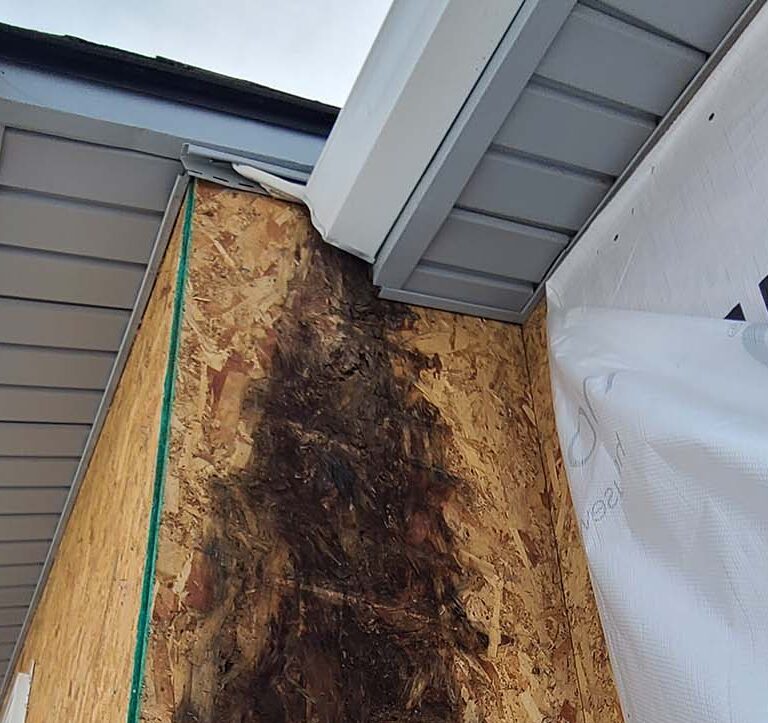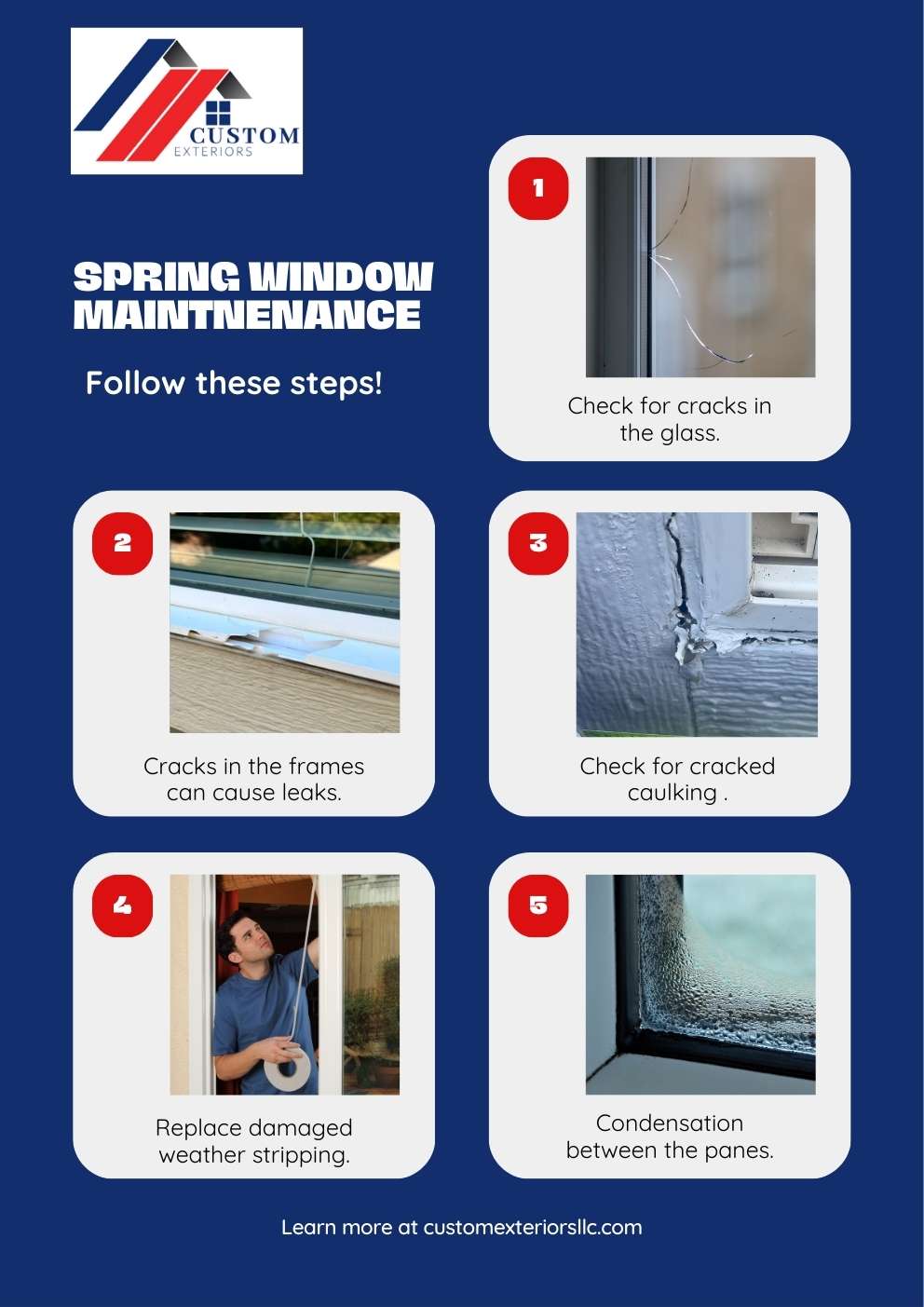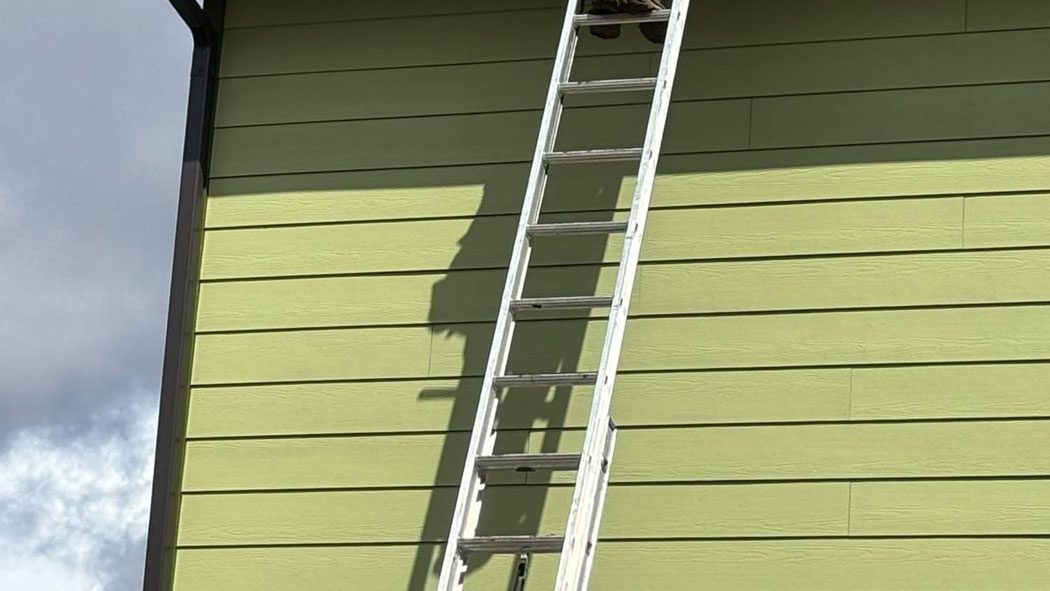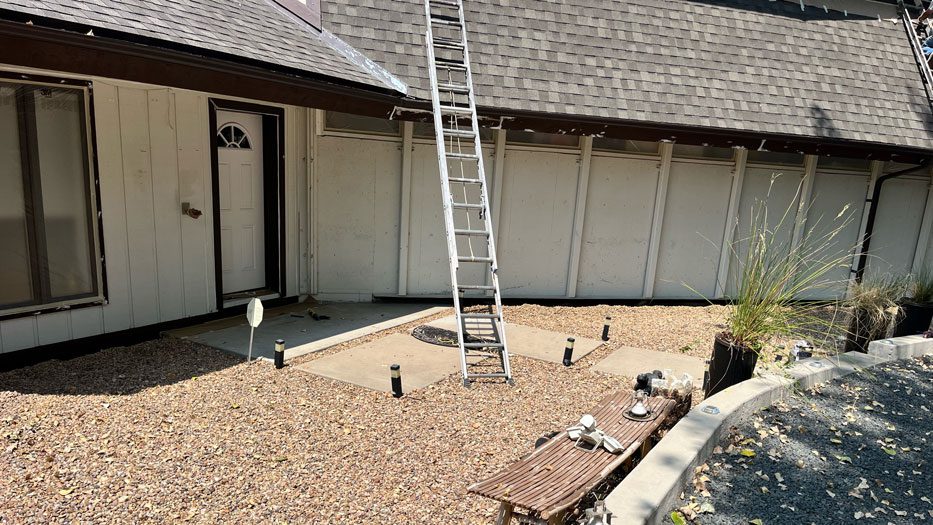Spring Forward: The ultimate guide to exterior home maintenance
As the days get longer and the weather warms up, many homeowners start thinking about spring cleaning and taking care of the exterior of their homes. Exterior maintenance is crucial for maintaining or increasing your home value and protecting it from damage. In Colorado, our homes face tough conditions like intense sunlight, strong winds, and heavy hail. Without regular upkeep, minor issues can quickly become expensive repairs. For example, clogged gutters can lead to water damage and mold, and neglected roofs can develop leaks that cause interior damage.
Beyond protection, the exterior of your home is the first thing people notice, creating their first impression. Regular cleaning and maintenance boost your home’s curb appeal and contribute to the overall look of your neighborhood, keeping your home from being “that house.” It shows pride in your home and reflects the care you put into it.
Spring is the ideal time for exterior maintenance, offering milder weather and longer days to get things done. After a harsh winter, spring cleaning lets you tackle any damage caused by the cold and prepare your home for the warmer (and, in our area, hail-prone) months ahead. By making this a yearly habit, you can catch potential problems early, keep your home structurally sound, and even increase its market value.
This guide will cover essential maintenance and cleaning tasks to ensure your home looks great and stays in top condition. Our experience shows us that you need the following items on your exterior spring cleaning list:
- Gutters
- Windows
- Caulk Sealing
- Siding
- Paint
- Roof
- Deck & Patio Furniture
Plus, we’ll touch on ten additional outdoor maintenance tasks that are key for springtime care.
Whether you’re a long-time homeowner or new to home maintenance, we have taken the experience our team has gained in decades of exterior construction and compiled a guide that covers most exterior maintenance issues. With prices of just about everything on the rise, we want to help you save some of your hard-earned cash by handling these tasks yourself! And by being proactive about maintenance, you are more likely to prevent costly repairs down the line. So, let’s get your house ready for those summer BBQs!
According to Thumbtack, the average home maintenance costs in 2023 rose to $6548. This is up $400 from just one year prior, which makes saving on home maintenance costs a must for today's homeowners.
Gutter care 101: Preventing damage with routine gutter maintenance
Gutter cleaning is a task that shouldn’t be overlooked in your spring maintenance. Yes, it is a chore. It requires you to practice ladder safety, is messy, and is one of our least favorite exterior chores. However, it’s a vital step in protecting your home. Take a look at the picture below. One of our crews found this during a recent siding replacement job. If this doesn’t explain why keeping your gutters clear is so important and what could happen if left neglected, I don’t know what will.

Your gutters play an essential role in directing the rainwater on your roof away from your home. If they are clogged with leaves, twigs, and debris, this water won’t be able to flow freely. This can lead to serious problems, like water damage to the roof, walls, and your home’s foundation. In extreme cases, overflowing water can create damp conditions ideal for mold and pests. If you live in an area with cold winters, clogged gutters are one of the main culprits of ice dams. Regular gutter cleaning can prevent these issues, ensuring water is efficiently channeled away from your home.
So, let’s talk about how you can clean your gutters. Here are three of the top methods:
Hand Cleaning:
Let’s start by saying this is the most disgusting method. You will be digging hands first into your gutters full of debris, rotting leaves, and possibly worse. However, it is also an easy and straightforward way to get the job done. Grab a ladder, gloves, and a bucket. Carefully set up your ladder and remove the debris by hand. While this approach is straightforward and requires no tools, it can be more time-consuming and requires a basic knowledge of ladder safety.
Gutter Scoop or garden trowel:
A gutter scoop is a small, shovel-like scoop designed to fit perfectly in your gutters to remove debris. Its flexible PVC design, which is just over a foot long and close to four inches deep, allows you to scoop large sections of debris at once. You can purchase one at most local home improvement stores for under five dollars. You will still need to climb a ladder, so consider your physical limitations prior to purchasing a gutter scoop. However, if you are comfortable at heights, its design allows you to increase the speed at which you complete the project due to its size.
Leaf Blower or Hose:
If the debris is dry and you are comfortable at heights, a leaf blower is the fastest and easiest way to clear your gutters. Alternatively, using a hose with an extended spray attachment or a power washer allows you to clean your gutters from the ground if you are uncomfortable with heights. That being said, this is the messiest of all of the techniques, so be prepared to get a little wet! Because of its efficiency, this method is the one used by our maintenance technicians. With the strategic use of buckets and tarps, gutter cleaning with a leaf blower or power washer is fast and effective.
It’s important to remember that while gutter cleaning seems like a hassle, it is essential to keeping your home in good shape. Keeping your gutters clean and water directed away from your home will save you from costly repairs down the line and help keep your home looking great. So, roll up your sleeves and give your gutters some love this spring!
Window Cleaning and Maintenance: A Clear View to Home Care
According to Angi, hiring a professional to clean the exterior of your windows averages $219, with project pricing ranging from $150 to $302, depending on many factors, including size and the number of windows in your home.
No one likes cleaning windows. Most homeowners rarely clean the inside of their windows, much less the outside. This is often because they are more challenging to get to and substantially dirtier. Also, it seems difficult to avoid streaks and smudges, and it often feels like it’s just not worth the effort. However, professional window cleaning is expensive, with prices going nowhere but up. Also, there are many benefits to including your windows on your spring cleaning list, including:
- Improving Your Home's Exterior Appearance
- Increasing Natural LIght
- Extending The Lifespan Of Your Windows
- Enhancing Energy Efficiency
- Health Benefits (Reduction Of Dust)
- Early Detection of Problems
- A Better View
While all of these benefits are great, from a Colorado roofing contractor’s perspective, adding bi-annual window cleaning and inspection to your maintenance list can detect damage that could create larger problems down the line. Take a look at photos from a recent job where we encountered serious damage from a basic lack of maintenance. So, let’s break down the easiest ways to wash your windows and what else to look for during the process.

Easy ways to wash windows
1. Soap and Water:
Sometimes, the simplest methods are the best. Mix a mild detergent with warm water. Use a soft sponge or cloth to clean the glass gently.
2. Squeegee Method:
Most professional window cleaners use a mix of methods, one and two. After washing with soap and water, use a squeegee for a streak-free finish. Wipe the squeegee blade with a clean cloth between strokes. Pro tip: Work your squeegee from the top of the window to the bottom and use your clean cloth to remove any residual water from the bottom of the frame, helping to reduce streaks. A clean and dry squeegee works best for reducing smudging and streaking.
3. Vinegar Solution:
For those looking for a more natural or DIY cleaning solution, mix equal parts white vinegar and water. It’s excellent for removing tough grime, and, as a bonus, it’s eco-friendly!
Checking for damage
While cleaning your windows, it’s a perfect time to inspect your windows, frames, and surrounding trim for any damage. Even if you choose to skip the window cleaning, a basic inspection of your window glass, frames, caulking, weather stripping, and surrounding trim is recommended.

- Look for any cracks in the glass. Even small cracks can turn into big problems if not addressed in a timely manner.
- Examine the window frames for signs of chipping, rotting, or warping. This can affect the windows structure and insulation abilities.
- Ensure the caulking surrounding the windows is still intact. If it's cracking or peeling away, it's time to re-caulk.
- Check the weather stripping for any gaps or damage. Replacing it can improve energy efficiency.
Condensation between panes
If you notice condensation between the panes, it indicates a broken seal. This is not a DIY project and means the window is no longer as energy-efficient as it should be. This requires repairing or replacing and will likely require the services of a professional window replacement company.
It’s wise to take this time to assess the conditions of your window screens as well. With summer approaching, functioning, intact screens are a must for fresh air flow in your home. Repairing damaged screens is another project that can be expensive when completed by a professional and is a fairly easy DIY. One of the owners at Custom Exteriors made a step-by-step how-to video to help our customers take on this project confidently.
At the end of the day, window cleaning and maintenance are about much more than just sparkling glass. It’s also about ensuring the function and efficiency of your home. So, while we recommend adding window cleaning to your exterior spring cleaning checklist, at the very least, take a moment to inspect the elements we discussed. Your home will thank you for it.
Why caulk sealing is important
Caulking is used to seal the gaps and joints in your home – around windows, doors, siding joints, the roof, and even corners where different materials meet. It is a barrier to prevent air, water, and insects from entering your home. Keeping caulking in good condition helps maintain your home’s energy efficiency and prevents water damage, which can lead to more expensive repairs. You can quickly increase the energy efficiency of your windows with this simple and inexpensive task.
Where to inspect your exterior caulking
- Around Window and Door Frames
- Where Different Materials Meet
- Gaps or Joints in Siding
- Around Vents and Outdoor Pipes
- Around Roof Flashings and Penetrations
Removing Damaged Caulk
If you find old, damaged, or cracked caulking, it’s important to remove it before applying new caulk. You can easily do this with a caulk removal tool or a simple utility knife to carefully scrape away the old caulking. Be gentle to avoid damaging the surface underneath. After removing the old caulking and before replacing it, clean the area with some soapy water to remove any residue or dirt. Let it dry completely before replacing the caulking. Recaulking too quickly can trap moisture behind your caulking and cause mold or rot in the long run.
Replacing the Caulking
A silicone-based caulk is best for most exterior jobs as it is weather-resistant and flexible. Caulking comes in a variety of colors, so matching your existing caulking color should be simple with a trip to your local home improvement store.
Once you have the correct caulking, cut the tip of the caulk tube at a 45-degree angle. This makes it easier to apply in a smooth line. Hold the caulk gun at a consistent angle and gently squeeze the trigger to apply the caulk in a steady line. Try to keep the motion consistent for an even application. Once you have applied a thin line of caulking, wet your finger and run it along the caulk line to smooth it out. This also helps push the caulking into the gap for a better seal.
Pro Tips For Exterior Caulking:
- Before you apply new caulk, make sure the surface is clean and dry for best adhesion.
- For exterior caulking, silicone or polyurethane caulk is usually best as it withstands weather conditions and temperature changes.
- Caulk on a day with mild temperatures, as extreme heat or cold can affect how the caulk sets and adheres.
- New caulking should be installed on a dry day, as it needs time to dry and set before getting wet.
- Don't apply too much caulk. It's easier to add more than to remove excess.
Remember, maintaining the caulking on the exterior of your home is a relatively simple and cost-effective way to protect your home from the elements and keep it energy-efficient. Plus, it keeps your home looking neat and well-kept, so take a little time to inspect and fix up any old caulking.
Cleaning and Maintaining your exterior paint and siding
It’s obvious why your siding and exterior paint are on this list. They make up the largest portion of your home’s facade and have the most impact in regards to the curb appeal of your home. Unfortunately, with time, they start looking dirty and dingy. In Colorado, long, snowy winters create dirty messes that can impact the appearance of your siding. The areas directly surrounding our homes are often exposed to dirt. Combine this with water, and your siding will likely need a good cleaning come spring.

Routine Cleaning of Paint and siding
When cleaning your siding and paint, the key is to give it a gentle wash. Whether you use a soft brush and garden hose or a power washer depends on your preference.
If you go with the brush method, use a soft brush and a mix of mild detergent and water to clean your siding and painted surfaces. After scrubbing, rinse everything off with a garden hose. Avoid harsh chemicals or abrasive tools that could damage the paint or siding. While hand scrubbing is thorough, it takes more time and can be challenging at higher elevations, often requiring ladders or special tools.
Using a pressure washer can save a lot of time while still effectively cleaning your home’s exterior. If you choose this method, start with the lowest pressure setting and gradually increase it as needed. Be careful not to use too much pressure, as it can damage the siding or strip away paint. High-pressure water can cause serious damage, like breaking holes in vinyl siding or denting wood or engineered siding.
When using a hose or pressure washer, be careful not to spray water behind the siding. Newer homes usually have a moisture barrier, but older homes might not. Either way, be mindful of the direction you spray to avoid forcing water into gaps between the siding panels.
Inspecting and maintaining Paint and siding
While cleaning, it’s the perfect time to inspect your siding and painted areas for any issues. The main concerns to look for are:
- Peeling or Chipping Paint
- Cracks or Damage in Siding
- Signs of Water Damage, Such As Rot or Mold
Look for areas where the paint is peeling or chipping. The elevation of the house that receives the most direct sunlight is also most susceptible to peeling paint or fading caused by UV rays. Faded or peeling paint is nearing the end of its useful life. While it can be unsightly, the protection quality paint provides to your siding should be the primary consideration. If it has peeled off or is significantly faded, your siding is at risk for damage, and the paint should be repainted or touched up.
Check for cracks, warping, or damage to siding panels, which can lead to more significant problems like moisture intrusion. Some types of siding, such as fiber cement siding products, are more prone to cracking. If not installed properly, they can crack over time, exposing your home to possible water damage. The urgency of this task cannot be overstated, as the risks of not maintaining the exterior are significant.
Damaged paint and siding can lead to water damage. Watch for signs of mold and mildew, especially in shaded or moisture-prone areas.
The best practice for maintaining your exterior paint and siding is to clean them at least once a year to remove grime and built-up dirt. If you find any issues during this time, call a professional siding replacement company and address them quickly with high-quality replacement products.
Pro Tips For siding and paint maintenance
- Always start with the gentlest cleaning methods to avoid damaging the paint or siding.
- Before using any cleaning product or tool, do a spot test in an inconspicuous area to ensure it doesn't damage the surface.
- Avoid painting or extensive repairs in extreme weather conditions, as this can affect the drying process and end result.
Remember that regular exterior maintenance of your home’s exterior paint and siding keeps it looking beautiful and protects it from wear and tear. By following these simple steps and staying vigilant for any signs of damage, you can keep your home in excellent condition for years.
Roof Maintenance: keeping your home's top in tip-top shape
When you think of spring cleaning or even exterior maintenance, your roof often doesn’t make the list. However, taking care of your roof is a big part of maintaining your home’s health. Let’s talk about how to keep your roof in great condition, what to look for during a roof inspection, and some important things to remember. When we talk about “cleaning the roof,” many picture the same process that was used for the siding on the home. However, cleaning and maintaining your roof looks very different from most of the exterior components of your home. Cleaning and maintaining your roof consists of 3 crucial steps.
Remove Overhanging Branches and organic growth
If you have trees or shrubs near your home, make sure the branches don’t hang over your roof. Overhanging branches can drop leaves and debris, leading to clogs in your gutters. Additionally, during severe wind storms, we have seen many large branches fall and severely damage the roof and exterior of the home. When trimming overhanging branches, be aware of your surroundings, as power lines can be buried in the branches of the tree, making them difficult to see. Depending on your skill level, this may be a project for which you hire a skilled roofing professional.
Not often in Colorado, but in more humid climates, you might see green moss or other growth on your roof. It’s important to gently remove these, as they can trap moisture on your roof and cause interior damage.
Conducting a roof inspection
It’s wise to check the overall condition of your roof twice a year by performing a thorough roof inspection. Check if any shingles are cracked, bent, or missing. These are signs your roof might need some repairs. Take note of the condition of roof flashing (the metal surrounding the penetrations in your roof and along any walls that meet your roof) to check for rusting or damage. This flashing is the first line of defense towards redirecting water off the roof and through the gutters and not into your home in the form of water damage. It’s also a good time to inspect all of the parts of your roof and the vents, soft metals, and drip edge for signs of damage.
It’s also a good time to look inside your home for signs of leaks like water stains on your ceiling. This could be an issue with a traditional leak due to water intrusion or improper roof ventilation. Either way, it’s best to catch it quickly to prevent water damage, roof sagging, and rot.
Cleaning your asphalt shingle roof
It’s important not to wash asphalt shingle roofs with high pressure, particularly because they are coated with small granules that can be dislodged with high water pressure. “Cleaning” your roof is more about removing larger debris and inspecting for vulnerable areas that could allow water intrusion.
If your roof needs cleaning, use the gentlest method possible. Sometimes, a light spray with a garden hose is all you need. Never use harsh chemicals or heavy pressure, as you may ruin your roof in the process.
Your roof is by far the most challenging system regarding exterior maintenance. If you are unsure about the safety of the inspection process, it’s best to call a professional roofing company. If you decide to inspect your roof, be very careful. Some customers have told us they use binoculars from the ground to quickly overview the roof’s condition. Whether you are doing it yourself or calling in a local roofing company, it’s good to look at your roof regularly and catch any issues promptly.
Deck and patio furniture: Keeping your outdoor spaces inviting and safe
Your deck and outdoor furniture are important parts of enjoying your home. Let’s go through some simple steps to keep them looking great and staying safe for you and your family.
Deck Maintenance
- Sweep your deck regularly to remove dirt and leaves. Once a year, give it a thorough clean with a mild detergent or a deck cleaner.
- Look for any loose boards, nails sticking out, or rotting wood. These can be safety hazards and should be fixed as soon as possible.
- Every few years, it's a good idea to seal or stain your deck. This protects the wood from moisture and keeps it looking nice.
Patio Furniture care
- Avoid using harsh chemicals or abrasive brushes that can damage the finish of your deck or furniture.
- Just like other parts of your home, your outdoor furniture needs regular inspections for damage to catch problems early.
- If your furniture is in a sunny spot, consider using UV-protectant sprays to prevent fading.
Additional areas in need of spring maintenance
- Lawn Care and Landscaping
- Fence Inspection and Repair
- Outdoor Lighting Check
- Driveway and Walkway Repairs
- A/C Unit Maintenance
- Pest Inspection
- Pool Cleaning and Maintenance
- Chimney and Fireplace Inspection
- Sprinklers System Check
- Inspect and Repair Outdoor Play Equipment
Wrapping it up: Your guide to a well-maintained home exterior
And there we have it! We’ve covered a lot, from the importance of gutter cleaning to keeping your windows, roof, and deck in top shape. Taking care of your exterior isn’t just about making it look good. As we have discovered, it’s the key to protecting your home and ensuring it stays solid and safe for years.
Keeping up with these maintenance tasks can seem like a lot, but it’s really about small, regular checks and fixes. This way, you avoid big problems and expensive repairs later on.
Don’t be afraid to call in the professionals when you need to, especially for tasks that might be too big or dangerous to do on your own. And always remember, your safety should always be your primary concern. While DIY projects are nice due to a sense of accomplishment and money savings, your safety is more important than any money saved.
By following these simple tips and keeping an eye on your home’s exterior, you’re taking care of a place full of memories and special moments. So, grab that ladder, that bucket of paint, or just your garden hose, and give your home the love and care it deserves. Here’s to a home that looks as wonderful on the outside as it feels on the inside.
Contact Us Today
We Service and Support the Following Brands









Contact
Custom Exteriors, LLC
2881 S. 31st Ave, Greeley, CO 80631
109 E. 17th St. Ste 5822, Cheyenne, WY 82001
102 S. Tejon St. Ste 1100, Colorado Springs, CO 80903
404 Broadway, Eagle CO 81631
Phone: 970-460-8714
Toll Free: 800-580-0131
Quick Links
© 2022 Custom Exteriors, LLC


